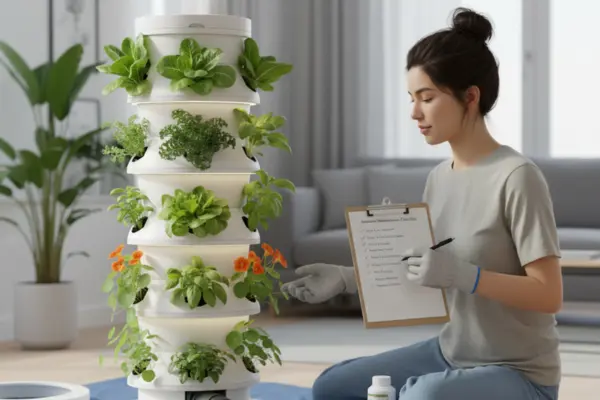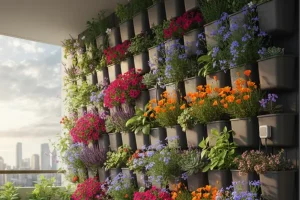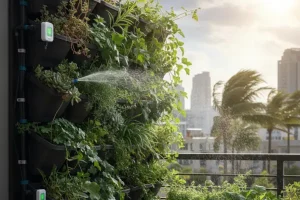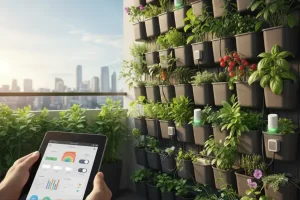Vertical gardens are often seen as “set it and forget it” solutions, but like any garden, they require care throughout the year. While these systems can be incredibly efficient, each season brings its own challenges—whether it’s heat stress in summer, frost in winter, or pests in spring.
That’s why having a seasonal maintenance checklist is essential. With a little regular attention, you can keep your vertical garden healthy, productive, and running smoothly all year long.
Why Seasonal Care Matters
Vertical systems rely on several moving parts—pumps, tubing, timers, nutrients, and growing media. When one piece slips, the whole setup feels it: water flow becomes uneven, leaves yellow from nutrient swings, or roots struggle in hot or cold weather.
Seasonal care is your simple way to stay ahead of those changes. As temperatures, daylight, and humidity shift, your garden’s needs shift too. A light tune-up each season keeps everything balanced and running smoothly.
Seasonal care ensures:
- Consistent plant growth and reliable harvests
- Fewer equipment breakdowns and surprise leaks
- Lower risk of pests, algae, and fungal diseases
- A longer lifespan for pumps, tubing, and containers
- Better nutrient use and less waste
In spring, you might rinse lines, replace clogged emitters, and start a gentler nutrient mix for young plants. Summer often calls for shorter, more frequent watering cycles and a close eye on reservoir temperature. In autumn, pruning and replanting keep towers productive while you dial back feed strength. Winter is the time to clean thoroughly, add grow lights if needed, and insulate or move systems away from drafts.
Instead of scrambling when problems pop up, you’ll be ready for each seasonal shift—with clear routines that protect your plants and your gear.
Spring Checklist
Spring is the season of growth, making it the perfect time to refresh your system.
- Clean and Sanitize: Flush out reservoirs, pumps, and tubing to remove salt buildup and algae.
- Replace Growing Media: Swap out worn or compacted media (like coco coir or clay pebbles).
- Check Pumps and Tubing: Make sure all parts are working before heavy use begins.
- Start Seedlings: Begin indoors if needed, then transplant once conditions are stable.
- Inspect for Pests: Aphids and whiteflies are common in spring—treat early with natural methods.
Summer Checklist
Summer brings rapid growth but also higher stress from heat.
- Increase Watering Cycles: Plants transpire more, so adjust timers for more frequent watering.
- Add Shade Cloth: Protect plants from intense afternoon sun.
- Monitor Reservoir Temperature: Keep water between 65–75°F for healthy roots.
- Watch for Pests: Spider mites thrive in hot weather—check undersides of leaves.
- Harvest Regularly: Prevent overcrowding by picking crops frequently.
Fall Checklist
Fall is a transition season—time to shift toward cooler crops.
- Switch Crops: Move to spinach, kale, lettuce, and other cool-weather varieties.
- Reduce Watering: Cooler temperatures mean plants need less frequent watering.
- Flush the System: Clean out nutrient buildup from summer growth.
- Check Lighting: Days are shorter, so supplement with grow lights if indoors.
- Inspect Equipment: Replace worn tubing or failing pumps before winter.
Winter Checklist
Winter requires extra attention, especially in colder climates.
- Protect Against Freezing: Insulate outdoor reservoirs and cover plants if temperatures drop below freezing.
- Reduce Watering: Too much water in cool conditions can lead to root rot.
- Use Grow Lights Indoors: Provide 12–14 hours of light daily for healthy growth.
- Add Supplemental Heat: Small space heaters or heating mats may be necessary for delicate crops.
- Focus on Hardy Plants: Kale, chard, and certain herbs tolerate cooler conditions well.
Quick Seasonal Reference Table
| Season | Key Tasks |
| Spring | Clean system, replace media, start seedlings, pest checks |
| Summer | Increase watering, add shade cloth, monitor reservoir temp, harvest often |
| Fall | Transition crops, reduce watering, flush system, check lighting |
| Winter | Prevent freezing, use grow lights, add heat, grow hardy crops |
Common Mistakes to Avoid
- Using the Same Setup Year-Round
Plants have different seasonal needs. Adjust water, nutrients, and light as conditions change. - Neglecting Equipment Checks
Pumps and timers work harder in summer and may wear out faster. Inspect and replace parts before they fail. - Overwatering in Cool Weather
Winter plants use less water. Overwatering is one of the most common cold-season mistakes. - Skipping Crop Rotation
Growing the same crop year-round depletes nutrients and increases disease risk. Rotate crops seasonally for balance.
FAQs
Q: Can I keep my vertical garden outside all winter?
Yes, but it depends on your climate. In freezing regions, you’ll need insulation, covers, or to move the system indoors.
Q: How often should I deep-clean the system?
At least once per season. Flushing between crops prevents salt buildup and algae growth.
Q: Do I need to change crops every season?
Not always, but rotating crops keeps the system balanced and reduces disease risk.
Q: What’s the easiest crop for year-round growing?
Lettuce is the most versatile. With the right lighting and temperature, it grows in every season.
Next Steps & Related Reading
To simplify maintenance, check out Automating Your Vertical Garden: Timers, Pumps & Controllers, which explains how to reduce manual tasks with automation.
If you’re just starting out, you might also enjoy Low-Cost Vertical Garden Systems You Can Build in a Weekend, which covers budget-friendly DIY options.
Conclusion
Vertical gardens are efficient and productive, but they thrive best with seasonal adjustments. By following this checklist, you’ll stay ahead of potential problems and enjoy harvests year-round.
A little preparation each season makes a big difference in keeping your garden healthy, your equipment running smoothly, and your harvests consistent.
What seasonal challenge do you struggle with most—heat in summer, pests in spring, or keeping plants alive in winter?




